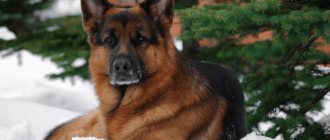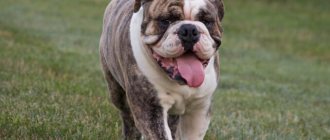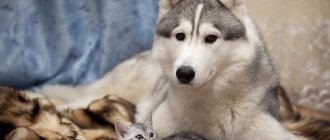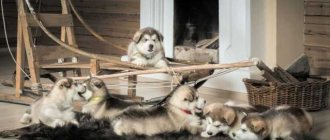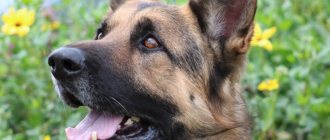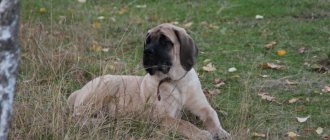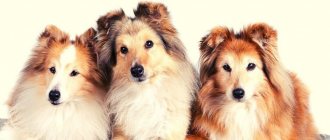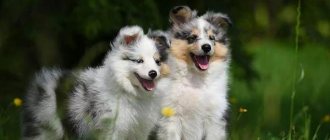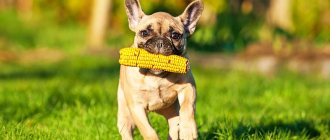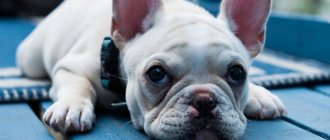History of the American Akita
American Akita
The word "American" in the breed's name can be confusing when it comes to its origins. The second name - large Japanese dog - is more eloquent in this regard: its homeland is the Land of the Rising Sun. But how did it happen that the Akita suddenly became American?
The ancestors of the American Akita are the Japanese Akita Inu, which were originally used for hunting and guard purposes. Several centuries ago they were called differently: Matagi-Akita. Later they began to be used in dog fighting, which became especially popular at the turn of the 19th and 20th centuries. In pursuit of monetary gain, owners sought to “improve” their dogs, making them larger and stronger. For this purpose, they were crossed with breeds brought to the islands such as mastiffs and shepherd dogs.
However, as a result of these manipulations, the classic features of the breed began to blur, deteriorate, or even be completely lost. The damage caused to the Matagi Akita was noticed at a dog show held in Tokyo in 1914. Soon, pure representatives of the breed were declared natural monuments, and their crossing with representatives of other species was strictly prohibited. The breeders had more work to do: they did everything possible to return the Matagi Akita to its original characteristics.
Before these magnificent dogs, which became the source of national pride for the Japanese, had time to recover from the blow inflicted on the breed by irrepressible human greed, World War II broke out. By order of the government, all breeders donated their pets to the needs of the front. As is known, the end of the war was marked by the surrender of Japan in 1945. Returning to their homeland, US military personnel decided to take with them several puppies they liked. It was they who became, a few years later, the progenitors of a new breed. But the actual classic Akita Inu remained on the Japanese Islands after the war, no more than 20 individuals.
Japanese Akita Inu
At the same time, overseas the breed began to gain widespread recognition and developed at a rapid pace. At first it was called a large Japanese dog. But in the States, work on the breed was not synchronized with the Japanese - it proceeded in parallel and, as they say, on its own path. Japanese breeders tried to negotiate with their American colleagues regarding her common pedigree, but in vain. They did not even allow dogs declared natural monuments on the islands to be exported to the United States. All these measures did not stop the Americans. As a result, over time, the overseas Akita began to differ from the Japanese one in both appearance and character. And then it received a new name - American Akita.
In 1956, a club for the newly formed breed was created, recognized by the American Kennel Club only in 1972. The “breed war” with Japan continued until 1992: for two decades, the kennel clubs of both countries did not recognize each other - only the Japanese Akita Inu was registered with the Fédération Cynologique Internationale (FCI). The official division of the breeds occurred only in 2000, when the FCI approved the standard for the overseas Akita.
Historical origin
Akita Inu is the national treasure of Japan. "Inu" means "dog" in Japanese, and "Akita" is the name of a mountainous province in the northern part of the island of Honshu. Akita Inu is a noble dog breed that was originally used to guard the Japanese royal family. Akita Inu was considered sacred, as evidenced by the existence of a law that strictly punished those who abused these dogs.
This breed is considered one of the oldest dog breeds on earth. Scientists have established the time of birth of the Akita Inu - 2 thousand years BC. e. based on remains found on Japanese territory and images in ancient drawings. Currently, the Japanese Akita Inu is known thanks to the wonderful, heart-warming film “Hachiko: The Most Faithful Friend.”
Features of the American Akita
The American Akita is an excellent hunter. If you suppress this natural quality in a dog, it will still manifest itself in one way or another, and not in the most pleasant way for the owner. For example, on a walk your pet will begin to rush at smaller dogs or “bully” the cat living in the same house.
The American Akita is also called a one-owner dog. She has a very hard time with a change of owner and often cannot adapt to living in another place for the rest of her life. A classic example is the famous Hachiko, an Akita Inu dog, who gained fame throughout Japan in 1932 after the publication in one of the largest Tokyo newspapers of the article “A devoted old dog awaits the return of his owner, who died seven years ago.” Based on this story, which touched the hearts of millions of people around the world, a film was made in 2009 with Richard Gere in the title role.
As you can see, the American Akita inherited this quality from its Japanese counterparts - devotion. It will be especially difficult to find common ground with an adult dog for those new owners who have not previously had experience communicating with large Molossians.
Temperament
By its nature, the Akita Inu is a friendly, obedient, intelligent, calm, reserved dog.
However, to train you will have to have a lot of patience, because this breed is quite wayward and stubborn and does not tolerate harsh methods of education. Akita Inu training should begin from an early age; only under this condition can its training bring positive results. Akita Inu is a very sociable dog, so it will become a wonderful member of any family; it is also suitable for single owners, for whom it can become an indispensable companion in any endeavor. This breed is perfect for living in a family with children. For small household members, Akita Inu will become the most faithful friend.
Akita is ready to give her love, affection and care to all family members, but under one important condition - people must treat her with respect and reciprocate. This four-legged dog always appreciates kind treatment, but it’s also very easy to hurt her dog’s feelings. The Akita treats strangers with a certain degree of mistrust.
Appearance of the breed
American Akita puppy
The American Akita is a very large dog. Strength and power can be read in her every movement. Gradually, the hunting skills of these dogs are becoming a thing of the past, which is largely due to their large size, which prevents the overseas “Japanese” from remaining fast and agile hunters.
Thanks to its special appearance features, namely its spectacular color and perfect lines, the American Akita has long been “registered” at dog shows in different countries of the world, including Russia. Representatives of the breed often lead in BESTS of the fifth group, often winning entire competitions.
general description
It is very difficult to confuse an American Akita with another breed - it is almost impossible, even if before “personal acquaintance” you had only seen it in a photo. The first thing that will catch your eye, in addition to its impressive size, is its strong body with well-developed muscles and massive bones. The “bear” type muzzle with small eyes and a relatively short bridge of the nose will definitely attract attention.
The height and weight of the American Akita, as well as the proportions of the body, vary depending on gender. The height of males at the withers varies from 66 to 71 cm, females - from 61 to 66 cm. The weight of adults is usually: males 45-65 kg, females 32-45 kg.
For males, the ratio of the height at the withers to the length of the body is 9:10, for females it is 9:11. The distance from the foot to the tip of the nose correlates with the distance from the foot to the occipital protuberance in a ratio of 2:3.
Head
American Akita muzzle
The head is the hallmark of the breed. Massive, but at the same time in harmony with the body. There are no skin folds (wrinkles) - provided that your pet is in a calm state. When viewed from above, the shape of the head resembles an obtuse triangle.
The skull is wide and flat, with a shallow groove running upward along the forehead. The transition from forehead to nose (stop) is well expressed, but not sharp.
Wide and voluminous muzzle with powerful, square-shaped jaws. The suspension of the jaws is light. The ratio of muzzle length to skull length is 2:3.
Teeth
The bite is characterized as a regular scissor bite. However, the breed standard also allows for a straight bite. The teeth are strong, the dental formula must be completely present.
Eyes
The Akita's eyes are small, almost triangular in shape, and deep-set relative to the size of the head. Color – dark brown. The eyelids are black and fit tightly.
Ears
The ears are also small in relation to the rest of the head.
Standing, triangular in shape. They have a wide base on strong cartilage, slightly rounded at the ends. The setting is not too low. Above the eyes, at the level of the scruff of the neck, slightly tilted forward. When pulling the ear forward, its tip should ideally touch the edge of the upper eyelid. If you look at the Akita's ears from the side, they seem to continue the top line of the neck.
Nose and lips
The nose is black, wide, the nostrils are well open. Liver color is allowed, but only the American Akita is white. Although it is still preferable to “classic” the breed, that is, the black color of the nose.
The lips are also black, dry, and fit tightly. The tongue is pink.
Neck
Massive, thick and relatively short, with minimal dewlap. Muscular, widening towards the shoulders. The scruff has a good convexity, smoothly passes into the base of the skull and merges with it.
Frame
The body length of the American Akita exceeds the height of the dog at the withers. The chest is wide, voluminous and deep.
The depth of the chest is equal to half the height of the animal at the withers. The ribs are distinguished by sufficient convexity (arched).
The belly is moderately tucked. The back is straight, the lower back is muscular and strong, with a slight convexity. The skin is elastic and fits tightly.
Tail
Covered with straight, thick and coarse hair, it does not form a dewlap. Its base is large and powerful. The tail is set high and the Akita carries it over its back. Or, as an option, the tail touches the side. The tip must reach the back or fall below its level.
The tail is bent into a ring, sometimes double, forming three-quarters of a circle. The last vertebra, when fully rotated, reaches the hock joints.
Limbs
The forelimbs have powerful bones and look straight when viewed from the side. Shoulders moderately sloping back, strong and firm. Elbows should look strictly back, not turned outward or inward. The pasterns have a slight slope, about 15 degrees to the vertical. The paws are round in shape, “cat” type, the direction is straight. The pads are thick and elastic, the fingers are arched with strong claws.
The hind limbs are also distinguished by strong bones and powerful muscles. Hips are well developed and strong. The metatarsals have a fairly low location and are not turned outward or inward. The knee joints, when viewed from behind, are parallel and characterized by moderately pronounced angles. Paws are straight-directed, with elastic pads, round ("cat" type). The fingers are convex (arched) and equipped with strong claws. The so-called dewclaws, that is, the fifth in a row, are usually removed.
The American Akita's gait is characterized by strong, free movements. They are also distinguished by a moderate lunge and push. The movement of the front and hind limbs is carried out in the same plane.
Wool
The coat is double and has a dense undercoat. The guard coat is coarse and straight, while the undercoat is soft and dense and somewhat shorter in comparison with the outer coat.
The hair on the head, ears and limbs is short. Its length at the rump and withers is approximately 5 cm, which is slightly longer than on other parts of the body, with the exception of the tail. It has the longest and most abundant fur – over 6 cm.
Color
White American Akita
The breed standard here is very democratic, allowing any color options, including white, fawn-white, red and brindle. American Akitas can even be piebald, that is, spotted (pinto) - with or without a mask. Instead of a mask, there may be a spot on the forehead or a dent on the muzzle. The mask is completely eliminated only in white individuals. White individuals have black lips, nose and pads.
The colors of dogs of this breed are clear and pure. The spots have clear contours and are evenly spaced. In the Pinto, the spots on a white background are evenly distributed, covering the head and more than one third of the dog's body; a dark-colored mask is allowed.
The color of the undercoat may differ from the coat color.
Possible defects
- Absence of any tooth, with the exception of 2 PM-1 and/or M3.
- Short tail.
- Light eyes.
- Males of the bitch type and, accordingly, bitches of the male type.
- The tongue is blue or with black spots.
- The presence of a collar or fringes.
- Turning of the elbows (inward or outward).
- Anger or, conversely, timidity.
- Lightweight frame.
- Insufficient body weight.
Disqualifying faults
- Partially or completely absent pigmentation of the nose (the so-called butterfly nose).
- Overshot or undershot.
- Semi-erect or completely drooping ears, with folds.
- The tail is straight or crescent shaped.
- The height of males at the withers is less than 63.5 centimeters, and that of females is less than 58 cm.
- Aggression or cowardice.
Any obvious physical abnormalities or problematic behavior is grounds for disqualification of the American Akita.
Please note: male dogs must have two healthy, developed testes, fully descended into the scrotum.
Akita Inu: appearance features
The uniqueness lies in the fact that this breed is purebred, without crossing with dogs of other blood. Outwardly, this “Japanese miracle” resembles a triad of animals known to everyone: a fox, a wolf and a bear.
Breed standards:
- Height - from 58 to 65 cm at the withers (female). from 65 to 73 cm at the withers (male).
- Weight - from 32 to 45 kg (female). from 45 to 50 kg (male).
- The coat is coarse with a double delicate undercoat. The length of the coat is 5-7 cm, and may be longer on the tail. Large build with a wide and large triangular head.
- The ears are small, erect, triangular in shape, slightly tilted forward.
- The eyes are small, brown-rimmed, and slanted.
- The neck is thick and muscular.
- The back is straight, strong, the chest is wide.
- The tail is curled.
- Color - white. red with white coloring on the inner surface of the paws, chest and muzzle mask. brindle.
Photo of an adult American Akita
Character of the American Akita
The American Akita is distinguished by its independent and freedom-loving disposition. But at the same time, this is a calm dog, affectionate, balanced. Thanks to her mature, stable psyche, she behaves with dignity and shows restraint in any situation.
Waiting for the owner
Representatives of the breed never have causeless reactions to external stimuli. She does not bark over trifles, and without good reason she does not rush at anything that moves, just because it moves. Akita - smart, reserved, well-mannered and noble - such behavior is completely unusual.
If you keep your pet in an ordinary city apartment, you don’t have to worry that the American Akita will cause any inconvenience to your neighbors. There will certainly be no complaints about constant barking and howling. But if an Akita starts to vocalize, you can rest assured that there is a good reason for it! The barking of your pet is a sure signal that an ill-wisher has encroached on your territory or your property.
Dogs of this breed, like real samurai, love to keep everything under their control - apparently, this is how the genes inherited from their Japanese ancestors manifest themselves. This quality in the American Akita can be called one of the fundamental, because it helps her in fulfilling the mission inherent in nature - to be an excellent watchman. Take a closer look at your dog when he surveys his possessions: there is something bewitching in his gaze, inaccessible to human understanding.
The American Akita is distinguished by its boundless devotion to its owner and his family members. Like the Cane Corso, she gets along very well with children, often even looking after them like a nanny. But, unlike the “Italian,” our “American” cannot be trusted with children who are too young. Not at all because he is capable of offending them. On the contrary, when he feels threatened, he will, without hesitation, rush to protect the little household members. An Akita cannot be a full-fledged nanny due to its size. Leaving the baby alone with her, you cannot be completely sure that the dog will not accidentally push him or cause him some kind of injury. For some of the younger family members, the Akita will become a true friend, especially for teenage children. They won't find a better companion in active games and various pranks!
At the same time, the breed is absolutely not characterized by such traits as obsessiveness and importunity. Although the Akita was specifically bred to live with humans, it still needs its own space. The “American” will never get in your way, but at the same time, you should not impose yourself on him again.
American Akita with a child
The peculiarities of the “inner world” of the breed also include intolerance to rudeness on the part of the owner and other household members. If an American Akita is yelled at or punished unfairly, she becomes very offended. Never raise your voice at your pet, do not offend him, and especially do not use physical punishment on him.
The American Akita feels great in a country house with a spacious yard. A large territory is her element: there is something to protect, and there is a place to feel like a master. When keeping a dog in an apartment, under no circumstances turn your pet into a “prisoner” of your square meters. A representative of this breed needs not only regular, but also long walks. Moreover, you need to walk him twice a day for at least 1-2 hours. Walking just “for show” is not suitable for Akita. They should be interesting, rich, active, with elements of play and training. All these points will help maintain the dog’s physical and mental health at the proper level.
The American Akita has a remarkable memory and trusts its owner, so it is very important not to deceive the dog, it does not like this and remembers such moments for the future. That is, if you, for example, lured her with a treat or gave the command “Eat!” or “Go for a walk!”, but didn’t do anything, then you risk losing your pet’s trust: he will stop perceiving you as his leader.
Quite often, a problem such as aggression towards other dogs arises in Akita behavior, which can cause some trouble for the owner. It is to dogs: she often shows loyalty to cats, but only to “her own” - there will simply be no strangers in the territory she controls. As for other people's dogs, adult Akitas, especially males, almost never accept other dogs into their company. On walks, they often show their character not from the best side, provoking quarrels and fights. From this we draw a simple conclusion: when you find yourself with your pet in dog walking areas, under no circumstances let him off the leash.
American Akita with owner
Description and features
The Akita Inu breed is one of the top 5 oldest. It is believed that its representatives inhabited the planet before our era. Even the Hellenes, the ancient people of Greece, depicted these beautiful animals on the walls, painting them or carving them on stone. This dog was originally domesticated by hunting peasants.
They liked her due to her attractive appearance, agility and speed. People realized that they were dealing with a very capable hunter. And they were right. Until now, Akita is actively used by forest hunting enthusiasts to hunt various animals.
The rapidly growing popularity of the beast could not but go unnoticed by the rich nobility and even the Emperor of Japan himself. Breeders began to breed him. After this, an ordinary villager could not afford to purchase a high-quality representative of the breed.
Interesting! In Ancient Japan, the emperor issued a decree prohibiting harming the Akita Inu. Corporal punishment against such a dog was strictly punishable.
This is a truly unique breed, because it was formed by nature, without selection. That is, it does not have the genes of other dogs. The dog has not yet lost its sacred status. In the 20th century, people even created a society to preserve its species. This handsome hunter is also a companion. He likes people and some animals, so he happily makes friends with them.
The main characteristic of the Akita is loyalty. It is difficult to name a more loyal pet. He always shows trepidation towards his owner, is sincerely afraid of separation from him, and strives to always be near him.
Very vulnerable. Afraid of criticism and reproach. It suffers when a loved one moves away from him. Therefore, if you do not plan to regularly spend time with your pet, avoid purchasing a representative of this breed.
In the photo there is a dog of the American Akita breed, different from the Akita Inu in height, weight and body proportions
He has one more purpose - watchdog service. Such a dog can be not only your friend, but also your bodyguard. He cares about the peace of his family. Who is this pet suitable for? We recommend starting one for people who like sports and outings.
You will have to walk your Akita often, and not only in the vicinity of the house. She needs to regularly replenish her stock of emotions and gain impressions.
Akita Inu is responsible for guard duty, but will never bark without a reason
Training and education
Raising and training the American Akita should only be done by an adult with experience, will and a steady hand. The breed is not suitable for weak-willed people, not to mention the elderly and people with disabilities.
Training an Akita can be hard work for many, even experienced owners. But this is not at all because a dog of this breed is “slow-witted.” On the contrary, by nature she has an extraordinary mind, and before executing a command given to her, she will first think about whether it is worth doing. From the outside, it may look like the Akita did not understand what they wanted from her. It also matters how authoritative the owner is in her eyes. The “American” will obey only the one whom he considers his leader, his leader.
American Akita training
For the most part, American Akitas are very active and learn, generally speaking, quickly. But they, like people, can get stuck with routine. In the sense that a dog can simply get bored from following the same commands, therefore motivation is very important in the process of training and education. At the initial stage, it will be easy to get by with just praise and treats. In the future, you will have to show your imagination in what else to interest your pupil.
It happens that the puppy begins to demonstrate character: he is stubborn and does not want to follow commands. This is where we need to show who is in charge. This is quite simple to do: press the capricious one with his back to the floor and hold him in this position until he stops offering resistance. Or grab the puppy by the withers and press him to the floor - this method is also effective. At first glance, it may seem that with such actions the owner is showing violence towards the dog. However, in fact, these are effective ways to convey to the dog that he is its leader, and that he is stronger. In the future, the Akita will more than once try to take a leadership position, checking through disobedience to see if the owner has weakened his “grip” or begins to give in to her. Don't fall for such tricks!
The main purpose of the American Akita is to protect its owner, and it will try to always be nearby. To prevent such “care” from the pet from causing inconvenience, in the process of training and raising the puppy, it is necessary to pay special attention to the “Place!” command. Otherwise, the dog will be on duty near the closed door, waiting for you from work, sleep by your bed and persistently watch near the locked door to the bathroom.
Education and training
This perky dog can become a good student, but you should not count on him to always be obedient. No, he is willful and prone to demonstrating leadership, which is why he should be trained by a person with a similar quality.
It is important to show the animal that in this house it is not he who is in charge, but the person. Therefore, he will have to play the role of a subordinate. To achieve this, we recommend feeding your dog by hand. This way she will understand that you control the food and therefore are in charge. You also need to demonstrate your primacy during training. Teach your pet obedience from childhood.
You can yell at him if he does something inappropriate, like chewing on his shoes. But, never raise your hand to him! Monitor your dog’s communication with other household members and animals in the house. He should not show any signs of aggression. If an Akita Inu growls, remove it, for example, by locking it in an enclosure. Don't try to calm him down by stroking him!
Teach your dog to follow simple and complex commands, gradually increasing the duration of training. When going for a walk with him, keep the leash tight. When your pet gets used to being guided by you and stops pulling, you can give him freedom. Avoid walking near the roadway.
Care and maintenance
Caring for an American Akita is not difficult, but it must be done.
Hygiene procedures will help maintain your pet's health and beauty. In addition, daily care is the only way to promptly detect various diseases at an early stage and take the necessary measures. The breed has a thick “fur coat” with a soft undercoat that is not prone to matting. The coat does not need cutting, but it needs to be washed regularly and combed with a metal comb 1-2 times a week. The coat is subject to shedding. The molting process is abundant, it occurs twice a year - in spring and autumn. During this period, the dog needs to be combed daily using a slicker brush or furminator.
American Akita at an exhibition
Eyes need regular examination. If you notice small gray lumps in the corners of your eyes, you shouldn’t worry too much; they can be easily removed with a soft, lint-free cloth. If you notice excessive souring of the eyes, swelling of the eyelids, constant tearing, immediately contact a specialist. Self-medication in such cases is unacceptable.
The ears should be thoroughly examined once a week. In a healthy ear, there is no excess wax; it is a beautiful pink color. The reason for contacting a veterinarian should be an abundance of wax, redness of the ear and an unpleasant odor coming from it, as well as a rash. Only a specialist can determine what the reason is. And there can be many reasons: ear mites, otitis media, allergies to certain components of the diet.
Akita teeth need to be brushed 3-4 times a week using dog toothpaste. You can use a brush or just apply it to your finger. It is important to prevent the appearance of tartar, so the condition of the dog’s oral cavity should be constantly monitored, and you should regularly take your pet for examination to the veterinarian.
After walks, be sure to wipe your American Akita's paws using damp towels and inspect them for cracks and injuries. It is necessary to rub vegetable oil into the paw pads and include it in the diet, one teaspoon per day is enough. This simple preventive measure will prevent cracks from appearing. To trim nails (this should be done once a month), use a large breed nail clipper. To avoid chips and burrs, sharp ends are smoothed with a nail file.
Health and Diseases of the American Akita
American Akita walking in the forest
The American Akita is naturally endowed with good health and good immunity. Her puppies, unlike representatives of some other breeds, are less susceptible to infections. However, there are ailments to which representatives of this breed are genetically predisposed: hip dysplasia, progressive retinal atrophy, epilepsy, bloating, entropion and inversion of the eyelids, infertility.
Hip dysplasia can develop primarily due to excessive physical activity during growing up and due to poor nutrition. That is, despite the genetic predisposition, this disease may not develop if you provide the Akita with a balanced diet and do not overload it during training. Infertility in some dogs can be observed due to hormonal imbalances.
In addition, representatives of the breed may suffer from allergic reactions, seborrheic adenitis, hypothyroidism, dermatitis, gastric volvulus, pemphigus, intolerance to anesthesia, as well as Cushing's syndrome (also known as hyperadrenocorticism). This disease affects the organs of the endocrine system due to excessive production of adrenocorticotropic hormone by the pituitary gland and the hormone cortisol by the adrenal glands.
The average life expectancy of the American Akita is 10-14 years.
Reproduction and lifespan
The lifespan of an Akita Inu depends entirely on how conscientiously the owners take care of it. A dog can live a long and happy life, but only if it is, firstly, fed properly, secondly, given vitamins to improve the condition of the coat and strengthen the immune system, and thirdly, if you regularly exercise with it .
Average life expectancy is 13 years. It is easy for a breeder of this breed to distinguish it from any other, because the Akita Inu has a unique, distinctive appearance. Dogs are bred on neutral territory and only during the female's menstrual period. If conception is successful, she will go into labor approximately 70 days after mating with the male dog. It is advisable to invite a veterinarian to the birth process.
How to choose a puppy
You should buy an American Akita puppy from trusted breeders who have been on the market for several years. It would be useful to find all possible information about the seller on the Internet and read reviews. An experienced breeder who values his reputation will definitely tell you which puppy is best for you. Some need a good hunter, others need a potential winner of all possible exhibitions, and others just need a good and faithful friend for themselves and their children, and to protect the house.
American Akita puppy with mom
Be sure to look at the parents of the future pet. This is very important because the offspring inherits their appearance and behavior. If it turns out that the mother or father is cowardly or, conversely, aggressive, then the puppy you choose may very likely turn out to be the same.
Be sure to pay attention to the appearance of the American Akita puppy. He should have shiny fur that is soft to the touch. While petting such a puppy, an association with a plush toy involuntarily arises. If he is too thin, has a swollen tummy, red and watery eyes, or twisted elbows and knees, then it’s better not to take risks and don’t take it. You should not take a puppy that is too young in age, since professionals do not assign show classes to dogs under 9 months.
Your future pet should be active. Lethargy in behavior is a sign of depression, which in turn may indicate a particular disease. If possible, to rule out hidden illnesses that may manifest themselves in the future, pay attention to the puppy's feces. Its consistency and color may confuse you. In this case, you should refrain from purchasing.
Photos of American Akita puppies
How much does an American Akita cost?
The American Akita is not widespread in Russia. It is even less common than its Japanese counterpart, the Akita Inu. But in large cities you can find nurseries for breeding these majestic beauties. There is a direct relationship between the cost of a puppy and the class to which it belongs.
- A puppy without a pedigree is relatively inexpensive, from 10,000 to 12,000 rubles. However, such savings are associated with the risk of having a non-purebred Akita or, even worse, a pet with developmental defects.
- You can purchase a pet-class puppy, due to any deviations from the breed standard, not suitable for breeding, but healthy, for 15,000 rubles.
- From 20,000 to 30,000 rubles. There are puppies with a pedigree and permission to breed, but at the same time they do not have a chance to become winners of exhibitions due to some minor deviations.
- Well, if you have your sights set on a high-breed Akita, a future winner of exhibitions and the owner of a variety of titles, then choose a show-class puppy - a descendant of titled parents. Such a baby can cost 50,000 rubles, and this price is minimal.
By choosing the right pet for yourself, you can be sure that in the future you will become a strong tandem with him, doomed to successful interaction. And over time, as you grow older, your American Akita will turn into a full-fledged member of the family - obedient and devoted.
Possible diseases and methods of treating them
Akita Inus are healthy and cheerful dogs. Unfortunately, they are often bothered by parasites, especially fleas. This primarily applies to individuals living on the street. To prevent your pet from encountering the problem of parasites, treat its fur with special drops or spray.
It is important to follow the instructions. It would also be a good idea to consult a doctor about deworming medications for your dog. Due to the abuse of natural food, his digestion may be upset. In this case, diet and gradual normalization of the diet will help.
